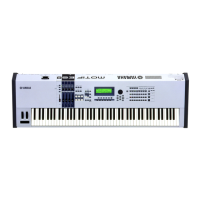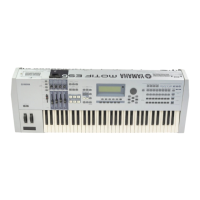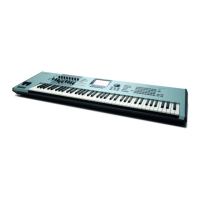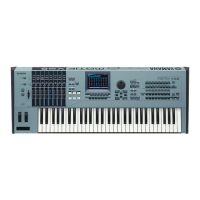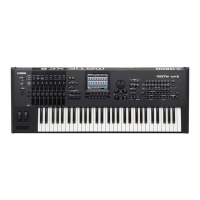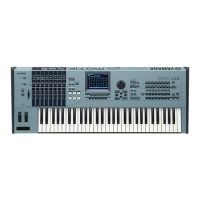Do you have a question about the Yamaha MOTIF ES and is the answer not in the manual?
Basic precautions for using electrical/electronic products to avoid injury or hazards.
Details on the importance of proper grounding for electrical shock risk reduction.
Warns against using the product in wet locations or near water to prevent electrical shock.
Alerts users about potential hearing damage from high volume levels and advises consultation.
Essential safety guidelines to avoid injury, death, damages, fire, or other hazards.
Prohibits use in wet conditions or near water to prevent electric shock.
Advises against placing flammable items on the unit to prevent fire hazards.
Instructions for immediate actions if cord damage, sound loss, smoke, or smells occur.
Instructions for initial setup, connecting to power, audio, MIDI devices, and computers.
Assists in resolving common problems with sound, operation, or unexpected behavior.
Guides on creating various types of data like Voices, Performances, Songs, and Patterns.
Procedures for storing edited data to internal memory and saving it to external media.
Detailed illustration and explanation of the front panel controls for MOTIF ES6 and ES7.
Detailed illustration and explanation of front panel controls, including buttons and keyboard.
Detailed illustration and explanation of the front panel controls specifically for the MOTIF ES8.
Illustration of the rear panel connectors and controls for MOTIF ES6, ES7, and ES8.
Detailed illustration of rear panel connectors including Plug-in slots, A/D INPUT, and OUTPUTs.
Detailed explanation of each rear panel connector, including Power, AC Inlet, mLAN, USB, MIDI, and Audio.
Instructions for connecting the MOTIF ES to an AC power source safely and correctly.
Guidance on connecting to powered speakers and mixers for audio output and routing.
Instructions for connecting via USB for MIDI data transfer and using software editors.
Details on connecting optional controllers like Breath Controller, Footswitches, and Foot Controllers.
Step-by-step instructions for powering on/off the MOTIF ES and connected audio equipment.
Procedure to restore the synthesizer's user memory to its initial factory settings.
Instructions for connecting microphones and audio equipment to the A/D INPUT jacks.
Guidance on connecting and controlling external MIDI devices using MIDI or USB connections.
Guidance on navigating displays and editing parameters using cursor buttons, data dial, and INC/YES/DEC/NO.
Explains selecting and playing instrument sounds (voices) in the Voice Play mode.
Instructions for selecting and playing Performances, combining multiple Voices in layers or splits.
Instructions for connecting microphones and setting up the A/D INPUT for audio input.
Guides for connecting high-level audio equipment and setting Mic/Line parameters.
Overview of Plug-in Boards and the Modular Synthesis Plug-in System for expanding sonic capabilities.
Comprehensive tools for creating original Voices by editing parameters in Voice Edit mode.
Describes main Voice parameters: sound creation, effects, controllers, and arpeggio settings.
Procedure for saving edited Voices to SmartMedia or USB storage devices in various file types.
Explains effect, Master EQ, controller, and arpeggio related parameters for Performances.
Procedure for saving edited Performances to SmartMedia or USB storage devices.
Guide to sampling sounds via microphone to create Normal Voices.
Guides on sampling audio devices to create Drum Voices and setting parameters.
Instructions for loading audio files from media to create Waveforms or Voices.
Details on executing Slice Job, returning to Pattern Play mode, and saving created patterns.
Introduction to creating songs, including recording keyboard performance and selecting voices.
Instructions for storing and backing up Voice/Mixing settings for songs and patterns.
Guides on recording drum loops from CDs using Sampling to create pattern tracks.
Instructions for loading audio files to divide samples and assign slices to MIDI notes.
Instructions for recording keyboard performance to an empty or existing track in Song Record mode.
Detailed editing of MIDI events within Song tracks using the Event List display.
Explains editing/deleting existing events and inserting new MIDI events in the Event List.
Overview of Song Job mode operations like Quantize for cleaning up track timing.
Details editing mixing parameters for Parts, including Common and Part Edit displays.
Saving created Song/Pattern data to SmartMedia/USB storage device before turning power off.
Instructions for saving Song/Pattern data as SMF or All files to storage media.
Introduces the Master function for memorizing and recalling operations via button press.
Instructions for naming and storing edited Master settings to internal memory or external media.
Details the two-step process for storing edited voices to internal memory and saving to external media.
Comprehensive tools for creating original Performances by editing parameters in Performance Edit mode.
Introduction to the Pattern mode for creating rhythm patterns as accompaniment for songs.
Overview of creating songs by assembling backing tracks and recording melody parts.
Guides on sampling audio material like sound effects or vocal phrases into a Song track.
Adjusting volume balance, pan, and effect levels for all parts using Song Mixing.
Instructions for storing edited Voices as User Voices to internal memory (Flash ROM).
Details storing edited Performances to internal memory and saving to external media.
Instructions for storing edited Performances to User memory (Flash ROM).
Ensures minimum system requirements are met and connects the instrument via USB.
Using sequencer software like SQ01 to play MOTIF ES voices and record sequencer data.
Intuitive editing of Mixing settings via software, adjusting parameters with mouse.
Intuitive creation and editing of Voices using the Voice Editor software via computer.
Using MOTIF ES knobs, sliders, and buttons to control DAW software like Cubase SX.
Configuring MIDI IN/OUT and Remote Control Setup for controlling computer software.
Detailed setup instructions for controlling various DAW software from the MOTIF ES.
Recording multitrack audio from MOTIF ES to DAW via mLAN for editing and storage.
Installing software and setting MIDI/Remote Control parameters on the computer.
Details handling audio input signals as Parts in Performance, Song, and Pattern modes.
Explains the Sampling function for importing and playing recorded sounds like Voices.
Specifies methods for starting sample recording: manually, by input signal level, or by song/pattern playback.
Explains the Effect block structure: System, Insertion, Master Effects, and EQs.
Explains MIDI basics, channels, and messages for electronic instrument communication.
Describes maintaining data through Store, Save, and Bulk Dump operations.
Details parameters like Oscillator, Pitch, Filter, Amplitude, LFO, and Envelope Generators.
Covers general operations for selected voices, including parameter settings.
Details parameters for Common Edit and Element Edit for Normal Voices.
Explains Play mode settings, MEQ Offset, Portamento, and OTHER parameters.
Parameters for editing individual Elements: OSC, OUTPUT, and LIMIT settings.
Explains LFO parameters (Wave, Speed, Reset) and EQ settings for Elements.
Details global parameters for Drum Voices, covering GENERAL, OUTPUT, and ARP settings.
Explains VELOCITY SENSITIVITY, AMP, and EQ parameters for individual drum keys.
Details common parameters for Plug-in Voices, similar to Normal Voice Common Edit.
Explains editing Elements for Plug-in Voices, covering OSC, OTHER, and SCALE parameters.
Details Pitch, Filter, and LFO parameters for Plug-in Voices.
Provides basic operations for Voices: Initialize, Recall, Copy, and Bulk Dump.
Function to store edited Voices to User memory (Flash ROM) and save to external media.
Explains editing individual keys within a Drum Voice, including OSC, OUTPUT, and PITCH settings.
Covers general operations for selected Performances, including parameter settings.
Details common parameters for Performances, including GENERAL, MEQ Offset, Portamento, and OTHER.
Details effect connections and parameters for Audio Input parts.
Parameters for editing individual Parts: VOICE, MODE, LIMIT, PORTA, and OTHER settings.
Explains EQ, TONE (Pitch, Filter), and AEG parameters for individual Parts.
Provides basic operations for Performances: Initialize, Recall, Copy, and Bulk Dump.
Function to store edited Performances to User memory (Flash ROM).
Covers general operations for Songs, including PLAY, GROOVE, and TRACK settings.
Details parameters for Song recording: PORT, OUT SW, TR LOOP, and PHRASE settings.
Details setting Voice, Arpeggio, and Click parameters for song recording.
Provides examples for Realtime Recording and Step Recording, including parameter settings.
Provides detailed controls for editing MIDI events in individual Song tracks.
Offers tools for editing and transforming Song data, including UNDO/REDO and NOTE data jobs.
Details the Quantize Job for adjusting note timing, including Strength and SwingRate.
Sets up mixing data for songs, adjusting Voice, level, pan, EQ, and effects.
Provides more detailed mixing parameters than Song Mixing mode, including MEQ Offset and Master Effect.
Details editing individual Parts of a Song Mixing, including VOICE, MODE, LIMIT, PORTA, and OTHER.
Offers basic operations for Song Mixing: Initialize, Recall, Copy, and Bulk Dump.
Stores edited Song Mixing programs to User memory (DRAM) and saves them as templates.
Explains recording methods (Replace, Overdub, Punch, Step) and Quantize settings.
Covers basic operations for Patterns: PLAY, Transpose, Measure, Arpeggio, Groove, TRACK, and PATCH.
Sets recording parameters like Type, Loop, Quantize, Tempo, and Voice for pattern recording.
Provides tools for editing and transforming pattern data, including UNDO/REDO and NOTE data jobs.
Sets up mixing data for patterns, adjusting Voice, level, pan, EQ, and effects.
Provides more detailed mixing parameters than Pattern Mixing mode.
Explains editing Mixing Voices, similar to Normal Voice parameters but for Songs/Patterns.
Provides Copy and Delete operations for Mixing Voices.
Stores edited Mixing Voices to User memory (Flash ROM or DRAM).
Guides creating samples and User Voices by recording external audio in Voice/Performance mode.
Details source selection, Next parameter, Mono/Stereo, Frequency, and REC button functions.
Guides creating waveforms or Sample Voices by recording external audio in Song/Pattern mode.
Explains WAITING, RECORDING, TRIM/SLICE display, and SLICE operation parameters.
Provides tools for editing recorded samples, including KEYBANK, TRIM, and PARAM settings.
Offers tools for changing sample sounds, including Copy, Delete, and Extract jobs.
Sets parameters for Tone Generator, Keyboard (Octave, Transpose), and Effect Bypass.
Configures audio input (Mic/Line, Digital) and output settings for jacks and mLAN.
Covers MIDI Sync (Internal, MIDI, MTC), ClockOut, SeqCtrl, and MTC StartOffset.
Sets MIDI channels, Device Number, and Switch parameters for MIDI communication.
Restores synthesizer's user memory to factory default settings (Factory Set).
Formats SmartMedia/USB storage devices and assigns Volume Labels.
Saves files to SmartMedia/USB storage devices, specifying file type and name.
Loads files from SmartMedia/USB storage devices, specifying file type and source.
Lets you play and edit special program combinations called Masters.
Applies global edits to all four Zones of a Master, including NAME and Knob/Slider settings.
Provides operations for initializing Masters and transmitting edited data to external devices.
Stores edited Masters to User memory (Flash ROM).
Edits individual Zones within a Master, covering Transmit, Note, and TX SW parameters.
Addresses issues where no sound is produced, checking sliders, volume, MIDI settings, and connections.
Checks microphone issues related to mode, Mic/Line setting, and Gain knob.
Basic precautions for using electrical/electronic products to avoid injury or hazards.
Details on the importance of proper grounding for electrical shock risk reduction.
Warns against using the product in wet locations or near water to prevent electrical shock.
Alerts users about potential hearing damage from high volume levels and advises consultation.
Essential safety guidelines to avoid injury, death, damages, fire, or other hazards.
Prohibits use in wet conditions or near water to prevent electric shock.
Advises against placing flammable items on the unit to prevent fire hazards.
Instructions for immediate actions if cord damage, sound loss, smoke, or smells occur.
Instructions for initial setup, connecting to power, audio, MIDI devices, and computers.
Assists in resolving common problems with sound, operation, or unexpected behavior.
Guides on creating various types of data like Voices, Performances, Songs, and Patterns.
Procedures for storing edited data to internal memory and saving it to external media.
Detailed illustration and explanation of the front panel controls for MOTIF ES6 and ES7.
Detailed illustration and explanation of front panel controls, including buttons and keyboard.
Detailed illustration and explanation of the front panel controls specifically for the MOTIF ES8.
Illustration of the rear panel connectors and controls for MOTIF ES6, ES7, and ES8.
Detailed illustration of rear panel connectors including Plug-in slots, A/D INPUT, and OUTPUTs.
Detailed explanation of each rear panel connector, including Power, AC Inlet, mLAN, USB, MIDI, and Audio.
Instructions for connecting the MOTIF ES to an AC power source safely and correctly.
Guidance on connecting to powered speakers and mixers for audio output and routing.
Instructions for connecting via USB for MIDI data transfer and using software editors.
Details on connecting optional controllers like Breath Controller, Footswitches, and Foot Controllers.
Step-by-step instructions for powering on/off the MOTIF ES and connected audio equipment.
Procedure to restore the synthesizer's user memory to its initial factory settings.
Instructions for connecting microphones and audio equipment to the A/D INPUT jacks.
Guidance on connecting and controlling external MIDI devices using MIDI or USB connections.
Guidance on navigating displays and editing parameters using cursor buttons, data dial, and INC/YES/DEC/NO.
Explains selecting and playing instrument sounds (voices) in the Voice Play mode.
Instructions for selecting and playing Performances, combining multiple Voices in layers or splits.
Instructions for connecting microphones and setting up the A/D INPUT for audio input.
Guides for connecting high-level audio equipment and setting Mic/Line parameters.
Overview of Plug-in Boards and the Modular Synthesis Plug-in System for expanding sonic capabilities.
Comprehensive tools for creating original Voices by editing parameters in Voice Edit mode.
Describes main Voice parameters: sound creation, effects, controllers, and arpeggio settings.
Procedure for saving edited Voices to SmartMedia or USB storage devices in various file types.
Explains effect, Master EQ, controller, and arpeggio related parameters for Performances.
Procedure for saving edited Performances to SmartMedia or USB storage devices.
Guide to sampling sounds via microphone to create Normal Voices.
Guides on sampling audio devices to create Drum Voices and setting parameters.
Instructions for loading audio files from media to create Waveforms or Voices.
Details on executing Slice Job, returning to Pattern Play mode, and saving created patterns.
Introduction to creating songs, including recording keyboard performance and selecting voices.
Instructions for storing and backing up Voice/Mixing settings for songs and patterns.
Guides on recording drum loops from CDs using Sampling to create pattern tracks.
Instructions for loading audio files to divide samples and assign slices to MIDI notes.
Instructions for recording keyboard performance to an empty or existing track in Song Record mode.
Detailed editing of MIDI events within Song tracks using the Event List display.
Explains editing/deleting existing events and inserting new MIDI events in the Event List.
Overview of Song Job mode operations like Quantize for cleaning up track timing.
Details editing mixing parameters for Parts, including Common and Part Edit displays.
Saving created Song/Pattern data to SmartMedia/USB storage device before turning power off.
Instructions for saving Song/Pattern data as SMF or All files to storage media.
Introduces the Master function for memorizing and recalling operations via button press.
Instructions for naming and storing edited Master settings to internal memory or external media.
Details the two-step process for storing edited voices to internal memory and saving to external media.
Comprehensive tools for creating original Performances by editing parameters in Performance Edit mode.
Introduction to the Pattern mode for creating rhythm patterns as accompaniment for songs.
Overview of creating songs by assembling backing tracks and recording melody parts.
Guides on sampling audio material like sound effects or vocal phrases into a Song track.
Adjusting volume balance, pan, and effect levels for all parts using Song Mixing.
Instructions for storing edited Voices as User Voices to internal memory (Flash ROM).
Details storing edited Performances to internal memory and saving to external media.
Instructions for storing edited Performances to User memory (Flash ROM).
Ensures minimum system requirements are met and connects the instrument via USB.
Using sequencer software like SQ01 to play MOTIF ES voices and record sequencer data.
Intuitive editing of Mixing settings via software, adjusting parameters with mouse.
Intuitive creation and editing of Voices using the Voice Editor software via computer.
Using MOTIF ES knobs, sliders, and buttons to control DAW software like Cubase SX.
Configuring MIDI IN/OUT and Remote Control Setup for controlling computer software.
Detailed setup instructions for controlling various DAW software from the MOTIF ES.
Recording multitrack audio from MOTIF ES to DAW via mLAN for editing and storage.
Installing software and setting MIDI/Remote Control parameters on the computer.
Details handling audio input signals as Parts in Performance, Song, and Pattern modes.
Explains the Sampling function for importing and playing recorded sounds like Voices.
Specifies methods for starting sample recording: manually, by input signal level, or by song/pattern playback.
Explains the Effect block structure: System, Insertion, Master Effects, and EQs.
Explains MIDI basics, channels, and messages for electronic instrument communication.
Describes maintaining data through Store, Save, and Bulk Dump operations.
Details parameters like Oscillator, Pitch, Filter, Amplitude, LFO, and Envelope Generators.
Covers general operations for selected voices, including parameter settings.
Details parameters for Common Edit and Element Edit for Normal Voices.
Explains Play mode settings, MEQ Offset, Portamento, and OTHER parameters.
Parameters for editing individual Elements: OSC, OUTPUT, and LIMIT settings.
Explains LFO parameters (Wave, Speed, Reset) and EQ settings for Elements.
Details global parameters for Drum Voices, covering GENERAL, OUTPUT, and ARP settings.
Explains VELOCITY SENSITIVITY, AMP, and EQ parameters for individual drum keys.
Details common parameters for Plug-in Voices, similar to Normal Voice Common Edit.
Explains editing Elements for Plug-in Voices, covering OSC, OTHER, and SCALE parameters.
Details Pitch, Filter, and LFO parameters for Plug-in Voices.
Provides basic operations for Voices: Initialize, Recall, Copy, and Bulk Dump.
Function to store edited Voices to User memory (Flash ROM) and save to external media.
Explains editing individual keys within a Drum Voice, including OSC, OUTPUT, and PITCH settings.
Covers general operations for selected Performances, including parameter settings.
Details common parameters for Performances, including GENERAL, MEQ Offset, Portamento, and OTHER.
Details effect connections and parameters for Audio Input parts.
Parameters for editing individual Parts: VOICE, MODE, LIMIT, PORTA, and OTHER settings.
Explains EQ, TONE (Pitch, Filter), and AEG parameters for individual Parts.
Provides basic operations for Performances: Initialize, Recall, Copy, and Bulk Dump.
Function to store edited Performances to User memory (Flash ROM).
Covers general operations for Songs, including PLAY, GROOVE, and TRACK settings.
Details parameters for Song recording: PORT, OUT SW, TR LOOP, and PHRASE settings.
Details setting Voice, Arpeggio, and Click parameters for song recording.
Provides examples for Realtime Recording and Step Recording, including parameter settings.
Provides detailed controls for editing MIDI events in individual Song tracks.
Offers tools for editing and transforming Song data, including UNDO/REDO and NOTE data jobs.
Details the Quantize Job for adjusting note timing, including Strength and SwingRate.
Sets up mixing data for songs, adjusting Voice, level, pan, EQ, and effects.
Provides more detailed mixing parameters than Song Mixing mode, including MEQ Offset and Master Effect.
Details editing individual Parts of a Song Mixing, including VOICE, MODE, LIMIT, PORTA, and OTHER.
Offers basic operations for Song Mixing: Initialize, Recall, Copy, and Bulk Dump.
Stores edited Song Mixing programs to User memory (DRAM) and saves them as templates.
Explains recording methods (Replace, Overdub, Punch, Step) and Quantize settings.
Covers basic operations for Patterns: PLAY, Transpose, Measure, Arpeggio, Groove, TRACK, and PATCH.
Sets recording parameters like Type, Loop, Quantize, Tempo, and Voice for pattern recording.
Provides tools for editing and transforming pattern data, including UNDO/REDO and NOTE data jobs.
Sets up mixing data for patterns, adjusting Voice, level, pan, EQ, and effects.
Provides more detailed mixing parameters than Pattern Mixing mode.
Explains editing Mixing Voices, similar to Normal Voice parameters but for Songs/Patterns.
Provides Copy and Delete operations for Mixing Voices.
Stores edited Mixing Voices to User memory (Flash ROM or DRAM).
Guides creating samples and User Voices by recording external audio in Voice/Performance mode.
Details source selection, Next parameter, Mono/Stereo, Frequency, and REC button functions.
Guides creating waveforms or Sample Voices by recording external audio in Song/Pattern mode.
Explains WAITING, RECORDING, TRIM/SLICE display, and SLICE operation parameters.
Provides tools for editing recorded samples, including KEYBANK, TRIM, and PARAM settings.
Offers tools for changing sample sounds, including Copy, Delete, and Extract jobs.
Sets parameters for Tone Generator, Keyboard (Octave, Transpose), and Effect Bypass.
Configures audio input (Mic/Line, Digital) and output settings for jacks and mLAN.
Covers MIDI Sync (Internal, MIDI, MTC), ClockOut, SeqCtrl, and MTC StartOffset.
Sets MIDI channels, Device Number, and Switch parameters for MIDI communication.
Restores synthesizer's user memory to factory default settings (Factory Set).
Formats SmartMedia/USB storage devices and assigns Volume Labels.
Saves files to SmartMedia/USB storage devices, specifying file type and name.
Loads files from SmartMedia/USB storage devices, specifying file type and source.
Lets you play and edit special program combinations called Masters.
Applies global edits to all four Zones of a Master, including NAME and Knob/Slider settings.
Provides operations for initializing Masters and transmitting edited data to external devices.
Stores edited Masters to User memory (Flash ROM).
Edits individual Zones within a Master, covering Transmit, Note, and TX SW parameters.
Addresses issues where no sound is produced, checking sliders, volume, MIDI settings, and connections.
Checks microphone issues related to mode, Mic/Line setting, and Gain knob.
| Polyphony | 128 notes |
|---|---|
| Wave ROM | 175 MB (when converted to 16-bit linear format) |
| Aftertouch | Yes |
| Multitimbral | 16 parts |
| Oscillators | AWM2 (Advanced Wave Memory 2) |
| Type | Workstation |
| Number of Voices | 64 drum kits |
| Effects | Reverb, Chorus, Master Effect, Master EQ |
| Sequencer | Up to 226, 000 notes |
| Arpeggiator | 1787 types |
| Display | 320 x 240 backlit LCD |
| Keyboard | 61/76/88 keys (depending on model) |
| Connectivity | MIDI, USB |
| Sampling | Optional with expansion |
| Storage | SmartMedia card |
| Connections | Headphone, Foot Controller, Foot Switch |
